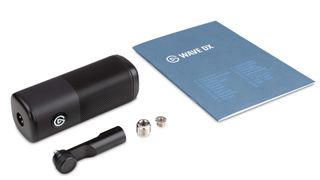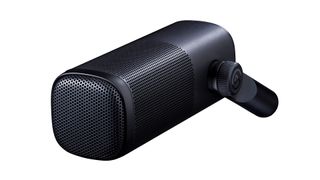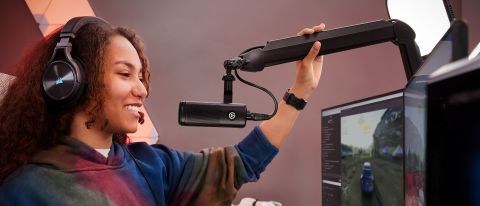TechRadar Verdict
The Elgato Wave DX is a great XLR mic that works well with XLR audio interfaces such as Elgato’s own Wave XLR or other compatible audio mixers. It’s easy to set up and has a very natural tone, making it great for streamers and podcasters who want to elevate their audio without blowing their budget.
Pros
- +
Great pricing
- +
Sleek design
- +
Excellent plosive reduction
Cons
- -
Is only as good as the interface it’s connected to
Why you can trust TechRadar
30-second review
While Elgato may already have some stellar microphones in its line-up, the new Wave DX is certainly one to get professionals excited. This XLR-only mic is sleek, easy to setup, and sounds like a dream. It’s designed to work with any XLR interface, though of course Elgato says the ideal pairing will be with its Wave XLR interface. Still, even when plugged into a regular mixer, the Wave DX does great work for podcasts, streaming, and even a spot of casual singing.
The price point is very much affordable as well, and sets it apart from other similar market products. Of course, the one downside to the Wave DX is that its performance very much depends on the interface its connected to . If you’ve got something as slick as the Wave XLR on hand, then you’re in for a treat – cheaper XLR interfaces will produce less than ideal audio recordings which really doesn’t do this microphone justice.
But the school of thought is that if you’re going to opt for an XLR microphone over a USB one, then you’ve already invested your money in a good interface as well, so you should have little to worry about.
Price and availability
The Wave DX is available now, and is priced at $99. That is a very affordable price point for an XLR microphone, considering something like the Shure MV7X retails at $179. The closest competition would come from the Blue Ember microphone, which also retails for $99.
While the Wave DX kit only includes the microphone, Elgato will also be offering various bundles that include the Wave DX, Wave XLR, Wave Mic Arm, and an XLR cable.
Design
The design of the Wave DX is extremely simple, and you don’t really get much in the box either. All you’ll receive is the microphone itself, along with 3/8“ and 5/8“ thread adaptors for attaching to a mic arm or stand.

The mic itself has a good weight to it, and features a subtle Elgato logo on the side that can be removed and reoriented depending on your setup. A small knob on the side allows you to pivot the microphone to your requirements, and that’s about it.

At the back is the single XLR port, and that wraps up all your connectivity. There are no other buttons or lights on this mic – everything you need to control will be with whatever interface you plug it into. The Wave DX features a dynamic capsule with a cardioid pickup pattern, which makes it great at picking up vocals and tuning out room or background noises.
Performance
The Wave DX does not require phantom power to operate, and will plug directly into any XLR interface. We used the Wave DX with our Razer Audio Mixer, which is our usual mixer for streaming and doing voiceovers.
You have to be fairly accurate with where you’re placing the microphone, as it really will only capture audio that’s directly in front of it. So if you’re positioning this mic to the side of you, you’ll want to adjust the mic so that it’s still pointing directly at your mouth and not at an angle.

The internal pop filter does a spectacular job at reducing plosives when talking, even when the microphone is very close to your mouth. The mic didn’t pick up the background hum of our air conditioning either, which is something we normally manually remove in editing.
Overall, our voice was recorded clearly and cleanly when we were talking directly into the microphone, and even when we used the Wave DX for streaming, it didn’t falter once when we shouted into it during heated moments. The Wave DX also supports various other features such as Nvidia’s noise suppression technology and other VSTs when used with Elgato’s Wave Link software (and a compatible interface).
The only area we found the Wave DX to be slightly falling behind is with vocal recording. The mic doesn’t quite have the richness to capture a vocalist without making the audio sound slightly tinny, so you’d have to do a fair bit of editing to really bring out the tones.
That’s not a huge mark against the Wave DX, but it’s just something to keep in mind if you’re thinking of using this microphone to sing on stream as well. It would benefit from having a few effects applied through a mixer to warm up the vocals a bit so there’s less to work on in editing.
Buy it if…
You want a no-nonsense streaming mic
The Wave DX does a great job for streaming, and cuts out unnecessary background noise by quite a lot. When paired with a proper mixer, you’ll get crystal-clear audio that sounds great every time.
You’re a podcaster
Speech is the Wave DX’s best friend, so it’ll have no problem recording hours of talking while ignoring background noises. Just make sure you’re positioning the microphone right in front of you, and you’ll be fine.
Don’t buy it if…
You have a cheap mixer
Connecting the Wave DX to a cheap mixer is going to do it a serious injustice, so if you haven’t splurged yet for a good XLR interface, then this mic isn’t for you.
A former IT & Marketing Manager turned full time Editor, Nick enjoys reviewing PC components, 3D Printers, projectors, and anything shiny and expensive. He can also be found baking up a storm in the kitchen, which we are more than happy to encourage.

Steve Jobs was wrong about the post-PC era and the next batch of iPads should embrace this

Soundcore's new sports earbuds offer a Powerbeats Pro-style customizable secure fit for a fraction of the price

Meta’s massive OS announcement is more exciting than a Meta Quest 4 reveal, and VR will never be the same again

